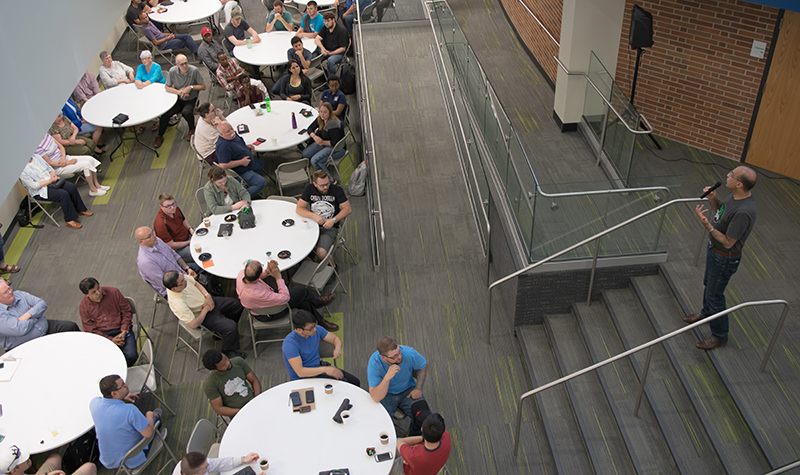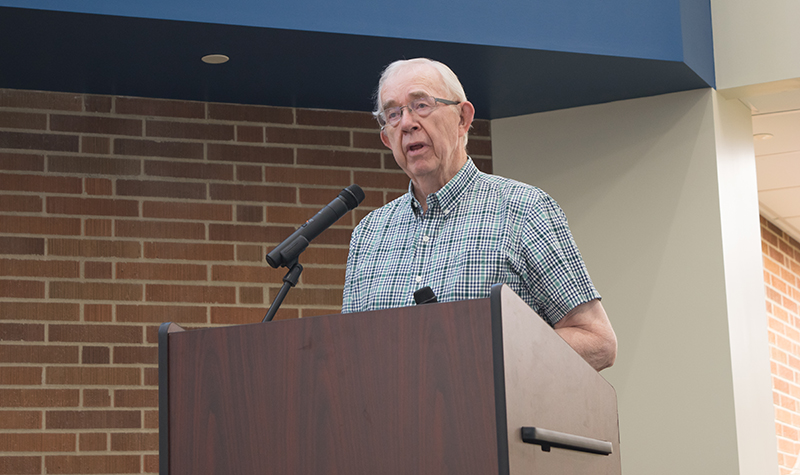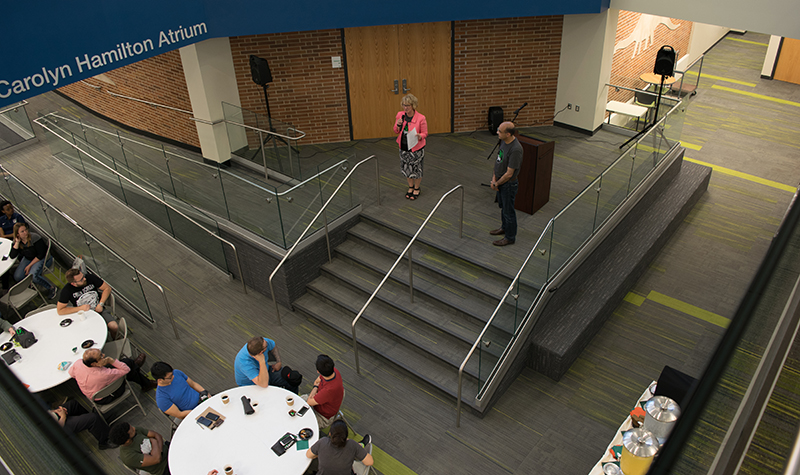10 Jun UND College of Engineering & Mines celebrates three decades of distance engineering education

After lunch outdoors, over 60 distance students as well as faculty and staff gathered at the Collaborative Energy Center last Thursday to mark the 30th anniversary of the distance engineering program at the College of Engineering & Mines. (Above) CEM Dean Hesham El-Rewini addressed the crowd. Photo by Dima Williams/UND Today.
In the late 1980s, Arnie Johnson had a new nickname. Fuzzy Arnie.
The electrical engineering professor, who arrived at the University of North Dakota in 1988, earned the moniker because of a task that is now enshrined in the annals of the University and of the discipline.
Johnson, who would also chair the department of electrical engineering, taught the first ever distance-education class in engineering at UND, and ostensibly across the country.
Lectures, led in empty auditoriums that resembled TV studios more than college classrooms, rolled on videotape to be snail-mailed to students. Technology, at the time, was very much still in its grainy inception, capturing blurry imagery. Hence, to the engineering learners beyond the Grand Forks campus, Johnson became Fuzzy Arnie.
“When the students came for lab the first year, they got to see what Arnie really looked like,” said Johnson, who has since retired.
Last Thursday, over 60 current online students met Johnson for the first time too, when they flocked to the College of Engineering and Mines’ Collaborative Energy Center to mark the 30th anniversary of the distance engineering program at UND.

Retired electrical engineering professor, Arnie Johnson recounted the challenges and rewards of teaching the program’s first ever course, disseminated to students via videotape in 1988. Photo by Dima Williams/UND Today.
A novel, outlandish and brazen idea in the 1980s, the program remains somewhat of a maverick, a unique opportunity in the academic and professional realms of engineering.
“We are the only university in the U.S. and as far as I know in the world that offers a full suite of programs, accredited programs, that are delivered via distance to undergraduate students,” said CEM Dean Hesham El-Rewini.
The beginning
In the fall of 1988, at the Conference for Industry and Education Collaboration, Jim Carter, then a manager at Minn.-based manufacturing corporation 3M, approached then-CEM Dean Alan Fletcher with a proposition – a UND course for 3M’s full-time employees.
Thus, after some deliberation, arose UND’s distance engineering program. The first class, Johnson’s, had 11 students, nine of whom completed it.
For each lesson, they waited some three weeks to receive the cassettes after Johnson had recorded them. Assignments and exams would arrive at Johnson’s desk with a lag of almost a month, too.
Cameras would sometimes fail, and Johnson had to start over. Chalk on old-fashioned blackboards did not appear clear on camera, so Johnson scribbled with black markers on large sheets of white paper.
“There was a challenge in the early days when every year we had to go through improvements of technologies, hardware, software,” said Johnson, who also directed the program for a number of years. “Every year, there were improvements.”

Over 60 current online students gathered at the Collaborative Energy Center to hear about the start and the continued success of distance engineering, which has graduated over 500 engineers. Photo by Dima Williams/UND Today.
And every year, the number of companies partnering with UND for its distance engineering offering grew. Hutchinson Technology, Cargill, Hewlett Packard and Sony, among others, joined.
Faculty secured national grants to develop the curriculum, parts of which – especially the Engineering 100 class – are still utilized today. The capstone course shifted from requiring on-campus work to on-the-job-site projects. The program expanded into various fields – petroleum engineering, geological, mechanical, civil, chemical. The list of attainments and enhancements swelled.
“The fact that we were the very first to offer such an innovative program was extremely exciting,” said Lynette Krenelka, executive director of TTaDA who used to provide technological and logistical support to the program through what was the office of continuing education. “We were serving a student population that was older than average.”
Accreditation in time of flood
The year of 1997 is etched into the psyche of UND. Spring delivered a record flood that shuttered campus only months before CEM succumbed to a rigorous accreditation audit by the Accreditation Board for Engineering and Technology, Inc (ABET).

Passing the muster of the leading engineering accreditation authority was no small feat, given that it arrived after the record flood of 1997, said Tom Owens, a retired chemical engineer and interim dean. Photo by Dima Williams/UND Today.
UND was among three universities nation-wide to be evaluated.
“The accreditation was a big deal because the concern with accreditation was that the distance programs were different from on-campus programs,” said Tom Owens, chemical engineering professor and one-time interim dean.
Further compounding the process was ABET’s new approach that dictated the assessment of students’ outcomes rather than professors’ inputs. At the time, the distance program had no graduates yet, Owens said.
Still, it earned full accreditation, attesting that CEM, in the quality of its classes, did not distinguish between on-campus and distance students.
“That was a big deal,” Owens said. “It still is a big deal.”
Student focus
Today, some 15 years after snubbing videotapes for online platforms, the distance engineering program boasts over 500 alumni – and hundreds more engineers in the making.
Through over 100 courses a semester, CEM offers fully online education – certificates or diplomas – in 28 engineering fields.
The last 30 years of pioneering “leaps and bounds” that have resulted in this array of options have a single impetus.
“This is about students,” said Owens. “It always has been.”


